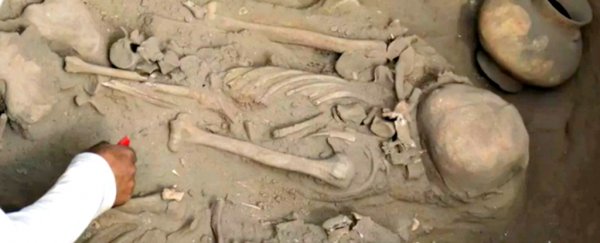Archaeologists have found the remains of 140 children in a mass grave on the northern coast of Peru – evidence they say suggests the largest ritual child sacrifice in history, according to National Geographic.
The gruesome scene also contained the skeletons of 200 baby llamas. Researchers estimate the event likely occurred around 550 years ago, when the area was controlled by the Chimú Empire, the second largest pre-Columbian society behind the Incas.
"I, for one, never expected it," John Verano, an anthropologist at Tulane University who worked on the dig, told National Geographic. "And I don't think anyone else would have, either."
Archaeologists were first alerted to the human remains after residents of the Peruvian city of Trujillo found weathered skeletons protruding from a bluff near their houses in the La Libertad neighbourhood in 2011. During a dig that year, archaeologists found the remains of 42 children, a number that has since increased.
The site is formally called Huanchaquito-Las Llamas and falls within a residential neighbourhood.
Verano is now working with Gabriel Prieto, an archaeologist at the Universidad Nacional de Trujillo, to publish their findings in a peer-reviewed, scientific journal.
Other South American civilizations, like the Incas and the Aztec, practiced ritual human sacrifice, but archaeologists have never found children's bodies in such a high concentration before.
The gruesome details of the slaughter
The details of the slaughter are disturbing. The children mostly ranged from around eight to twelve years old (though the youngest were five). The findings suggest they had their faces smeared with a red pigment, and the skeletons show signs of mutilation, including broken sternums and notches cut into the rib-cages. It seems the children's chests were cut open and their ribs dislocated in order to remove their hearts.
By examining layers of sediment and footprints around the site, the archaeologists concluded that the sacrifices were likely carried out over the course of a single day.
From the footprints, it appears that the children and llamas were led in a single line and sacrificed one after the other. There are even skid marks in the sediment indicating places where the sacrificial victims were reluctant to participate.
The children's bodies were buried facing west, towards the Pacific Ocean, while the llamas were buried facing east, toward the Andes mountains.
Along with the children's remains, archaeologists uncovered the bodies of one man and two women near the sacrificial site. The researchers think the adults may have performed the ritual killings then were executed shortly after.
The precise cuts on the skeletons indicate that the killings were performed by trained hands, according to National Geographic's report.
"It is ritual killing, and it's very systematic," Verano told National Geographic.
The killings could have been in response to an El Niño event
The researchers are now trying to figure out why these children were sacrificed. One theory: bad weather.
In the layers of sediment at the site, researchers found evidence that the region had experienced severe rainfall and flooding around the same time as the sacrifices, likely due to elevated sea temperatures from an El Niño event. The floods may have disrupted the region's agriculture, which could have led to mass starvation.
Child sacrifice may have been a last resort in the hopes that the gesture would improve the weather by appeasing the gods.
The Chimú empire once stretched across a huge swath of South America's Pacific coast, including current-day Peru, Ecuador, and Chile. But the archaeological record suggests they succumbed to an Incan invasion only a few decades after the sacrifices occurred.
"It makes you wonder how many other sites like this there may be out there in the area for future research," Prieto told National Geographic. "This just may be the tip of the iceberg."
This article was originally published by Business Insider.
More from Business Insider:
